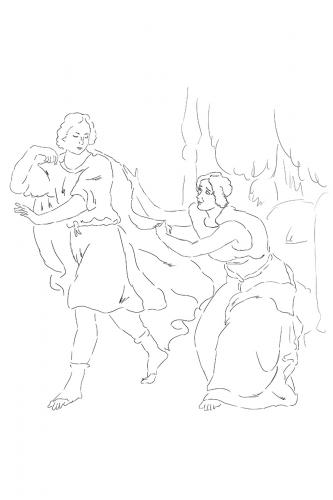



Joseph and Potiphar's Wife
The story of Patriarch Joseph’s youth has often been a source in Christian literature, allegorically foretelling Jesus’ life. Themes such as “The Selling of Joseph into Slavery”, “Joseph and Potiphar’s Wife”, or “Potiphar’s Wife Falsely Accusing Joseph” were seen as parallels to “Judah’s Treason”, “The Temptation of Christ” and “Jesus’ Process”. Although these are Old Testament references frequently employed, the scenes from Joseph’s life have been less evoked in Byzantine and Post-Byzantine art, compared to the notoriety they enjoyed in Western art since Early Christianity. That is why there are no explicit canons for such iconographical representations.
The scene “Joseph and Potiphar’s Wife” is very kinetic. Joseph's figure is emphasized, he is running away as the coat, slipping from his shoulders, is pulled by Potiphar's wife. The background, vaguely sketched, is irrelevant and the illustrator is free to use his imagination. There are, however, elements meant to suggest a space suitable for the scene: a bed was preferred in the Western art while an open door to the woman's room or an impressive chair from which she had just got up were the options for Early Christian art and its further developments in the Byzantine area. There is no special indication regarding the woman's garments, but her clothes must reveal the high social position of the husband. Really important iconographically is her gesture to get hold of the young man, doubtlessly indicating who is the aggressor and who the victim. Joseph is depicted half-turned to the viewer, closer to him in the foreground than the feminine character, suggesting thus his intention to leave. He is dressed in a tunic, letting slip his mantle or other sleeved garment clutched by the woman. Joseph's gesture is as ample as the woman's, its significance may vary from rejection to surprise or fear.
The story of Patriarch Joseph’s youth has often been a source in Christian literature, allegorically foretelling Jesus’ life. Themes such as “The Selling of Joseph into Slavery”, “Joseph and Potiphar’s Wife”, or “Potiphar’s Wife Falsely Accusing Joseph” were seen as parallels to “Judah’s Treason”, “The Temptation of Christ” and “Jesus’ Process”. Although these are Old Testament references frequently employed, the scenes from Joseph’s life have been less evoked in Byzantine and Post-Byzantine art, compared to the notoriety they enjoyed in Western art since Early Christianity. That is why there are no explicit canons for such iconographical representations.
The scene “Joseph and Potiphar’s Wife” is very kinetic. Joseph's figure is emphasized, he is running away as the coat, slipping from his shoulders, is pulled by Potiphar's wife. The background, vaguely sketched, is irrelevant and the illustrator is free to use his imagination. There are, however, elements meant to suggest a space suitable for the scene: a bed was preferred in the Western art while an open door to the woman's room or an impressive chair from which she had just got up were the options for Early Christian art and its further developments in the Byzantine area. There is no special indication regarding the woman's garments, but her clothes must reveal the high social position of the husband. Really important iconographically is her gesture to get hold of the young man, doubtlessly indicating who is the aggressor and who the victim. Joseph is depicted half-turned to the viewer, closer to him in the foreground than the feminine character, suggesting thus his intention to leave. He is dressed in a tunic, letting slip his mantle or other sleeved garment clutched by the woman. Joseph's gesture is as ample as the woman's, its significance may vary from rejection to surprise or fear.




